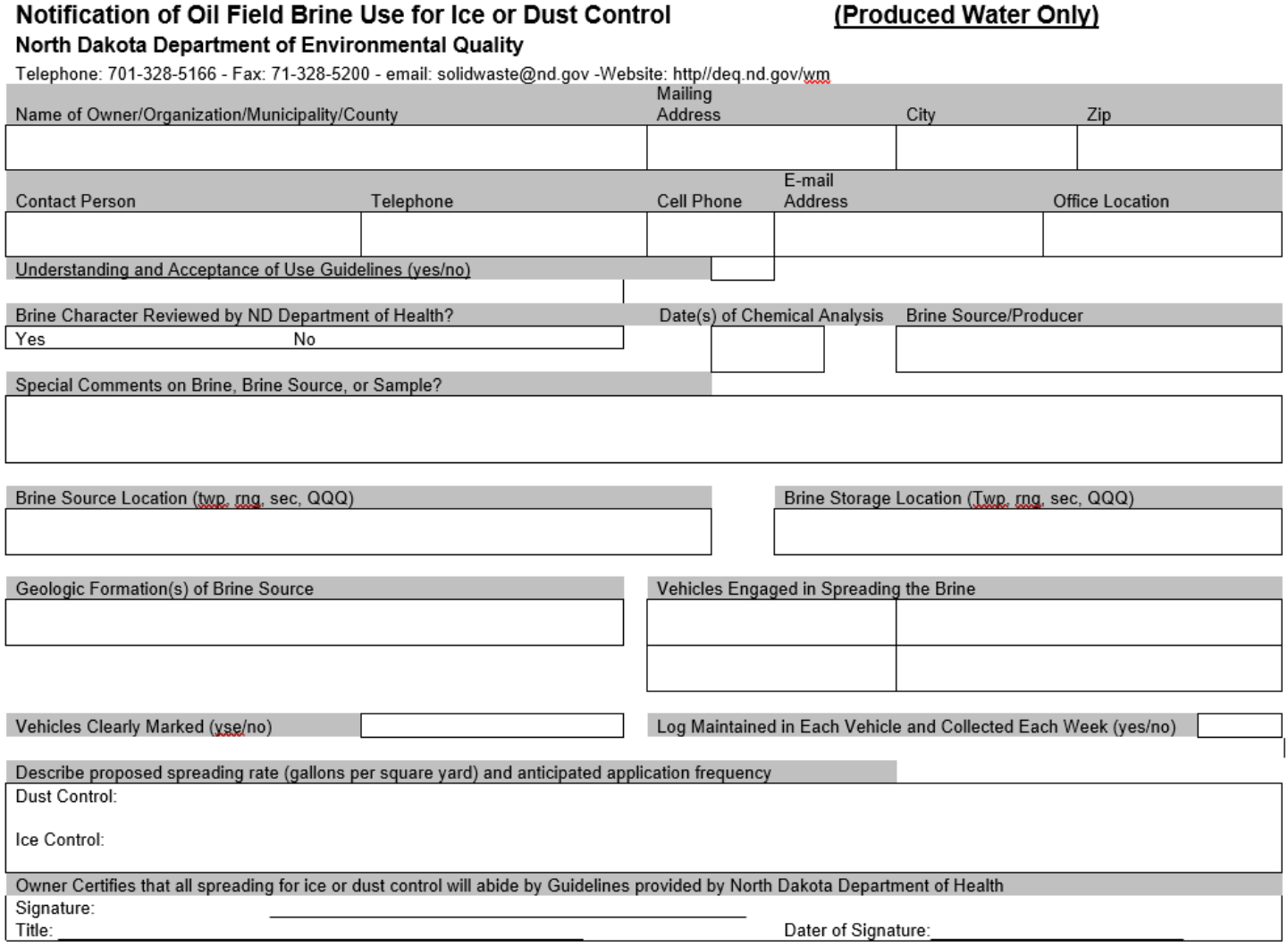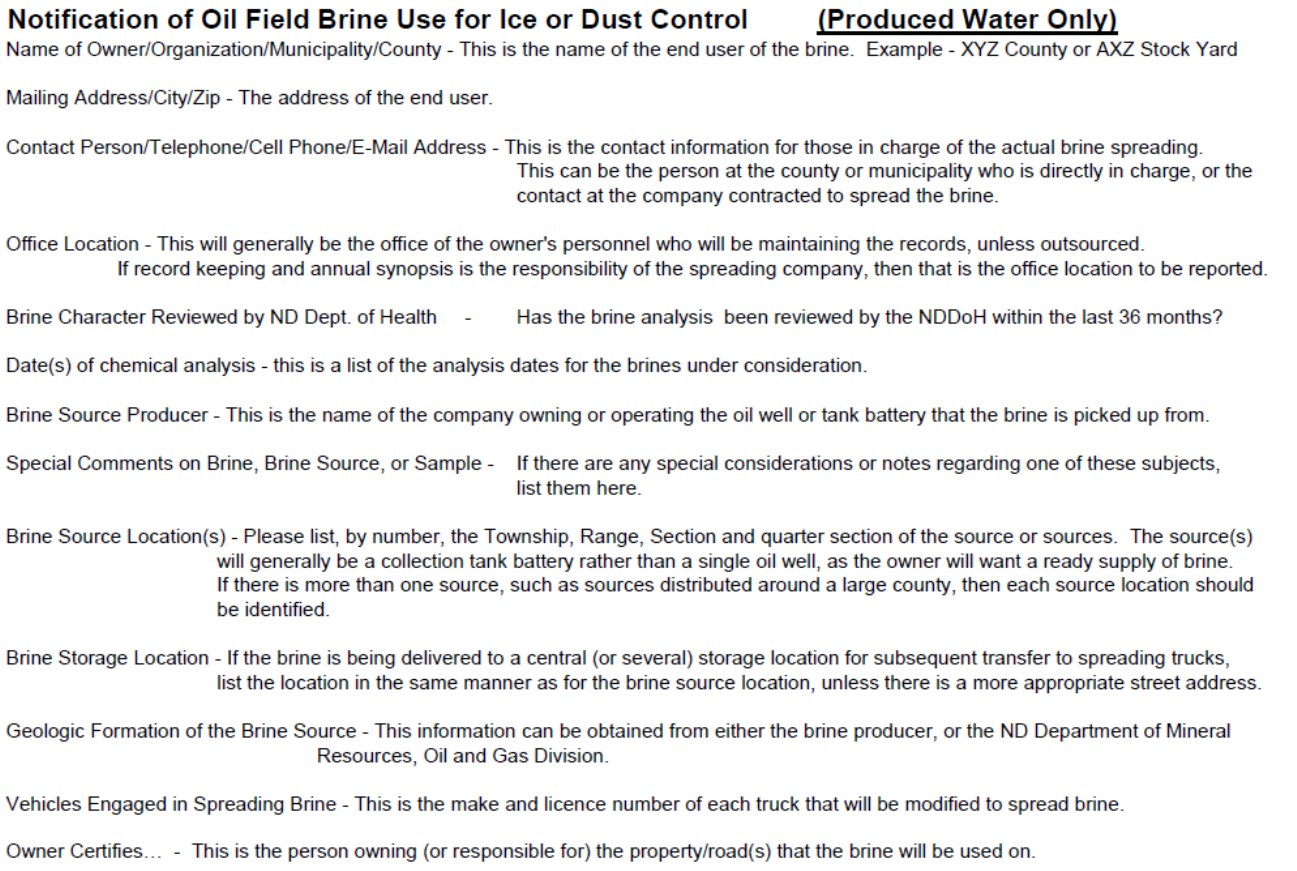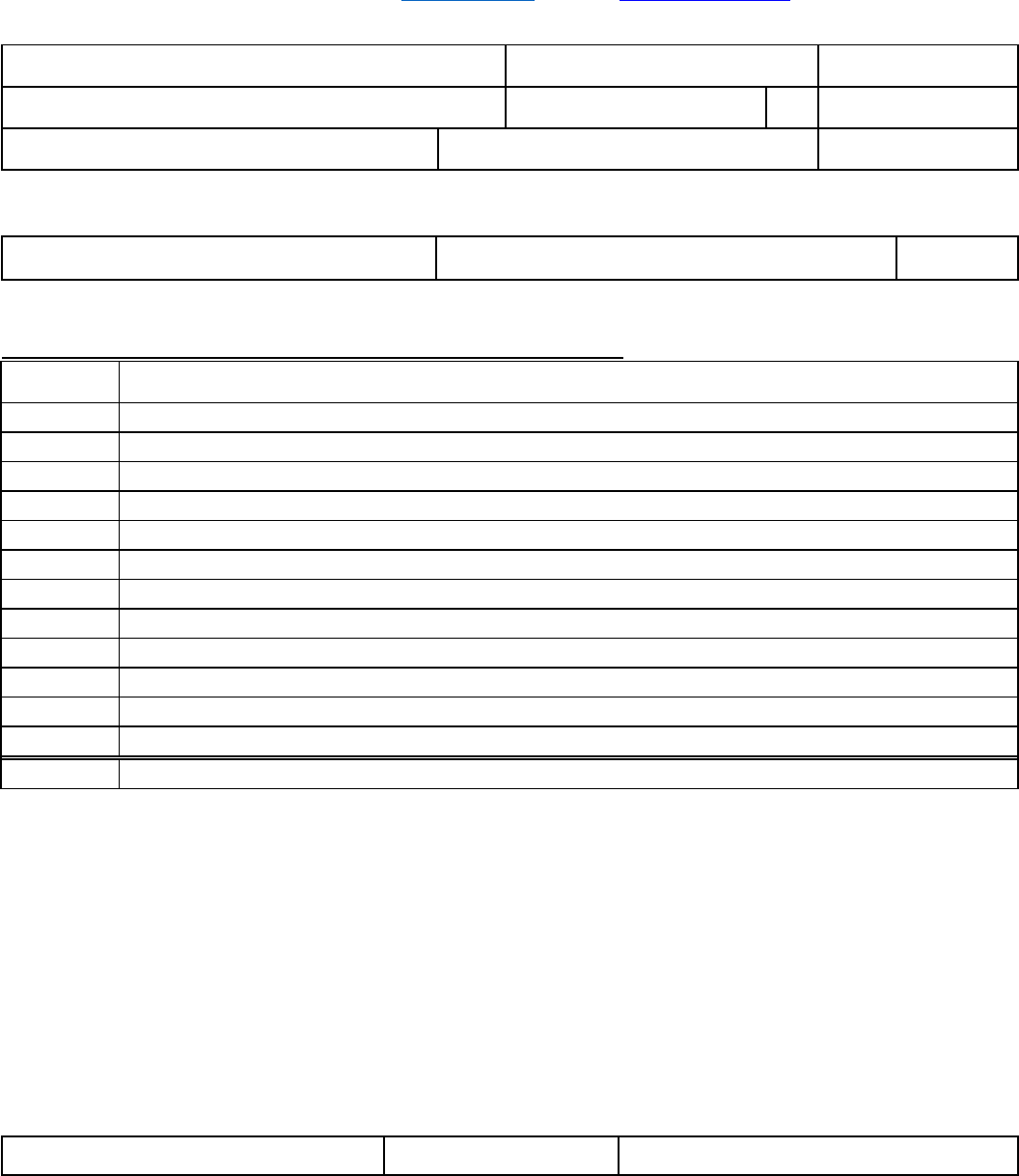
Introduction and Authority
Oilfield activity in western North Dakota has prompted interest in the potential beneficial use
or reuse of oilfield by-products that would otherwise be disposed of as waste. According to
the North Dakota Hazardous Waste Management Rules, North Dakota Administrative Code
(NDAC) 33.1-24-02-02(5)(a)(2), wastes are exempt from waste management rules and are not
considered a waste when they are: "(2) Used or reused as effective substitutes for commercial
products; ..”
Review and approval of a waste for beneficial use/reuse is managed by the North Dakota
Department of Environmental Quality (Department). Review, inspections and other
regulatory activities will be administered by the Department’s Division of Waste
Management and Division of Water Quality. When used in the manner outlined in the
guidance, a Department-approved brine source may be used for dust and/or ice control as a
substitute for commercial products.
The Department’s review of the beneficial use of produced water (also known as oilfield
brine) is based on the information presented and the Department’s knowledge of the issues
at that time. An approval is based on environmental and health issues only and does not
constitute an endorsement of the material. The name of the Department and its employees
shall not be used in any advertisement or endorsement without the Department’s written
consent. The Department reserves the right to request additional information and/or modify
or rescind an approval for use of the oilfield brine source (produced water) at any time.
All approvals from the Department for the beneficial use of produced water for dust and/or
ice control is limited to public roadways only [i. g., Township, County or State Roads].
Produce water use on any other roadway [i. g., lease or access roads] is subject to approval
from the North Dakota Industrial Commission – Division of Oil and Gas.
If produced water is used in a manner that does not fall within these guidelines, it may be
considered illegal disposal of a waste, and the user may be subject to penalties of up to $25,000
per day pursuant to the requirements in North Dakota Century Code (NDCC) Chapter 23-29 and
Chapter 61-28, and NDAC Article 33.1-16, Article 33.1-20, and Article 33.1-24.
Produced water intended for beneficial use must be used within 18 months after Department
approval. If not used by 18 months, the produced water must be disposed of at a permitted
facility.
Definitions
Owner/End User: The person, government or business that owns or has legal control over roads
or parking lots where produced water will be applied for ice or dust control.

Producer: The company which owns the oil well(s) and/or tank batteries from which
produced water will be acquired for the purpose of ice or dust control.
Transporter: The person or company transporting produced water from the producer’s
loading site to the owner/end user storage facility or spreading vehicle.
Produced Water Applicator: The driver and vehicle applying produced water to roads or
parking lots for ice or dust control.
Produced Water Source: The well or wells from which the produced water is collected from.
Testing
A produced water source or sources must be tested and approved by the Department prior to
applying. If the produced water source includes multiple wells, any change in the wells or
average amount received from each well may change the chemical/physical properties of the
water used for application and would require a new submittal of analytical results for approval
by the Department. All laboratory analyses must be conducted by a laboratory approved by the
Department.
Parameter List
Refer to “Appendix A – Parameter List” for a list of laboratory parameters to be analyzed for the
selected produced water source 60 days prior to anticipated use.
Frequency of Testing
The produced water source must be tested at least every six months or when changes to the
source has occurred. The results must be submitted to the Department for beneficial use
approval. Laboratory results must be submitted within 60 days of sampling for approval.
Criteria for Choice of Brine
At the minimum, the selected produced water for application must meet the following:
• Calcium plus magnesium concentration is greater than 10,000 milligrams per liter (mg/L)
• Chloride concentration is greater than 75,000 mg/L
•
1
Concentration of Radium 226 plus 228 must be below 5 pCi/g
• Laboratory results for a new produced water application source may be no more than
60 days old
• No visible sheen may be observed
1
(pCi per liter divided by TDS mg/liter) multiplied by 1000 mg/g = pCi/

Use, Application and Operation Procedures
Solid Waste Transporter Permit
Any person or company transporting produced water for the control of dust and ice or any
other waste material must obtain a Solid Waste Transporter Permit issued by the Department.
Vendors, generators and contractors using this material shall not deliver or allow transport of
this material by any transport company that does not have a valid permit. A permit application
may be downloaded at
https://deq.nd.gov/Forms/WM/PermitApplicationForTransportingSolidWaste.pdf .
Compliance and Education
Transportation and handling of this waste material must be in accordance with the North
Dakota Solid Waste Management Rules and Law, the North Dakota Solid Waste Transporter
Permit, this approval and any requirements of the North Dakota Industrial Commission -
Department of Mineral Resources - Oil and Gas Division (NDIC). Drivers of transportation
vehicles and any contractors, end users and any persons using or handling this material must be
instructed in proper handling of the waste material and be provided:
a. A copy of the beneficial use determination;
b. A Safety Data Sheet for this material;
c. Personal protective equipment appropriate for the material; and
d. Adequate information and equipment necessary for proper transportation,
handling, storage and use of the material.
All reasonable efforts shall be employed during material transport, handling and use to
minimize spillage, leakage, uncontrolled release, or airborne contaminants, including exposure
of workers engaged in using the material as well as in the environment.
All transporters and produced water spreaders shall be subject to spot checks by NDIC, the
Department and state or local law enforcement officers and the local health unit.
Produced Water Quality
Only produced water from oilfield sources shall be distributed for use as ice or dust control. No
drilling fluids, exploration fluids or work-over liquids shall be used in this capacity. Produced
water distributed for ice or dust control shall be free of oil and sludge, with no visible sheen and
leaving no visible sheen on applied surface.
Responsibility
The produced water producer shall notify the transporter and/or end user of any changes in
production sources or procedures that have the potential to change or alter the chemical or
physical character of the water.

Once produced water to be used for ice or dust control is transferred to a transporter or end
user, proper handling and use of the produced water is the responsibility and liability of the
transporter and/or end user. It is the owner’s responsibility to: (1) immediately report changes
in produced water quality/character to the Department, and (2) to ensure the transport and
end users are properly licensed.
The Department will notify the NDIC of wells supplying production water for application to
roads for ice and dust control.
Storage
Storage tanks for produced water prior to use should have a clearly legible sign identifying it as
produced water. A containment area and/or structure around the tank is recommended to
minimize the potential cleanup area if a release was to occur. The container should be
completely rinsed before filling with any other liquid after containing produced water to
minimize cross-contamination. Any spill which may cause pollution of waters of the state must
be reported immediately to the Department. Spill reports are to be filed electronically on the
environmental incident reporting weblink.
Spreading Guidelines
Produced water spreaders shall adhere to the following guidelines for the application of
produced water for dust/ice control:
a) When spreading produced water for dust/ice control, each vehicle shall display a clearly
legible sign identifying it as a produced water applicator (magnetic signs are acceptable).
b) The application of produced water to road surfaces must occur so that impact to the
environment is minimized. Produced water may only be applied at a rate and frequency
necessary to control dust/ice. The rate and frequency must be controlled to minimize
the impact of produced water infiltration to groundwater or producing runoff into
roadside ditches, streams, creeks, lakes or other bodies of water.
c) Spreading of produced water shall not create an objectionable odor generated from
hydrogen sulfide (NDAC 33.1-15-16-02.1).
d) A log of all spreading activity shall be completed and included for annual submittal to
the Department as listed under Reporting and Recordkeeping section of this document.
e) Recommended rates for dust control:
• Initial application of produced water shall be spread at a rate of one-half (1/2)
gallon per square yard, after the road or parking lot has been freshly-graded. In
areas where erionite is suspected, a light application of produced or clean water
should be laid down prior to grading to minimize dust production.
• Subsequent applications shall not exceed an application rate of one-third (1/3)
gallon per square yard per month, unless weather or traffic conditions require

more frequent applications to suppress the dust or stabilize the road bed. This
shall be noted in the application log and annual report to the Department.
• Application rates for race tracks and mining haul roads shall not exceed one (1)
gallon per square yard.
• Produced water for dust and ice control shall be applied by use of a spreader
bar, with shut-off controls accessible from the cab of the truck and/or other
types of spreading equipment approved by the Department.
• Recommended rates for ice control:
• Application rates shall be those used by the North Dakota Department of
Transportation (NDDOT).
• Consideration will be given to reducing the amount of produced water applied
near any stream creek, lake, wetland or other body of water.
• Consideration will be given to the amount of produced water applied on bridges
and culverts over streams, creeks, lakes, wetland or other body of water.
Unused Produced Water Disposal
Produced water that will not be used for Department-approved application is considered
special waste and must be disposed of at a permitted facility.
Reporting and Recordkeeping
Electronic Reporting and Submittal
All road or parking lot owners planning to use produced water for ice or dust control shall
initially notify the Department by mail or by electronic submission using the form provided in
Appendix B – Notification Form.
Any electronic or paper reports and submittals shall be sent to the following address:
North Dakota Department of Environmental Quality
Division of Waste Management
918 E. Divide Ave., 3
rd
Floor
Bismarck, ND 58501-1947
or
Please submit all electronic forms in a searchable pdf format.
Annual Reports, Submittal Due Dates and Record Retention
An annual report of the ice/dust control programs shall be prepared by the Owner/End User
and submitted to the Division of Waste Management. For ice control, the report shall be

submitted by June 1
st
; and for dust control, the report shall be submitted by January 1
st
for the
previous year’s activity. If using produced water for both dust and ice control, both reports shall
be submitted each year. Each annual report shall be maintained by the owner for a minimum of
three years. An example annual report form for submittal is included in Appendix C – Annual
Report Form. The annual report submittal shall also include a copy of the application log(s)
and a legible map marking road surfaces that received an application for the reporting period.
The annual report shall include an application log of all produced water application activities
that occurred over the reporting period. The application log must include all spreading dates,
rates, volumes, locations and the produced water source(s). A copy of the application log shall
be kept in the spreader truck and company/owner office. The office form shall be updated at
least weekly and kept on file for a period of three years. An example application log form is
included in Appendix D – operator’s Brine Spreading Log.
Annual reports, application logs and maps shall be made available upon request to inspectors
from the Department or local health units, state or local law enforcement and/or NDIC.
Additional Department Notification
Significant revisions to the spreading plan or produced water source shall be communicated by
letter to the Department before implementing the change. “Significant” shall mean change of
produced water supplier(s), produced water character, contact person, contract spreader, or
major change in spreading equipment.
Spill Reporting
Should any waste or material containing waste be spilled, released or otherwise discharged,
whether prior, during or after application, the material shall be properly managed to minimize
impacts to air, water and soil. Any spill, unapproved or accidental discharge of waste must be
reported immediately. The owner, operator or person responsible for a spill or discharge must
notify the Department as soon as possible (701.328.5150) or the North Dakota Hazardous
Materials Emergency Assistance and Spill Reporting number (1.800.472.2121) and provide all
relevant information about the spill. Depending on the severity of the spill or accidental
discharge, the owner or operator shall:
a. Take immediate remedial measures;
b. Determine the extent of pollution to waters, land or atmosphere of the state;
c. Provide alternate water sources to water users impacted by the spill or accidental
discharge;
d. Take any other actions necessary to protect human health and the environment; and
e. Non-emergency releases shall be reported by filling out the online Environmental
Incident Report Form: https://deq.nd.gov/eir/NonOilfield/ (releases of produced water
from truck transport are not exempt and should be reported using the General
Environmental Incident Report Form).

Appendices
Appendix A – Parameter List
Appendix B - Notification Form
Appendix C - Annual Report Form
Appendix D - Operator’s Brine Application Log
APPENDIX A
Parameter List

MINIMUM PARAMETER LIST for PRODUCE WATER
METALS
GENERAL CHEMISTRY
BASIC PARAMETERS
Aluminum
Alkalinity (Total)
pH
Antimony
Ammonia nitrogen
Specific Conductance
Arsenic
Barium
Oil & Grease
beryllium
Boron
Cadmium
Bicarbonate (HCO
3
)
RADIONUCLIDES (Naturally Occurring)
Copper
Carbonate (CO
3
)
Radium 226
Chromium
Calcium
Radium 228
Iron
Chloride
Lead
Fluoride
Nickel
Hydroxide (OH)
Selenium
Magnesium
Silver
Manganese
Thallium
Nitrate + Nitrite (as N)
Zinc
Phosphorus
Potassium
Sodium
Sulfate (as SO
4
)
Total Dissolved Solids
MAXIMUM/MINIMUM CRITERIA CONCENTRATIONS for PRODUCE WATER
PARAMETER
UNITS
MAXIMUM
MINIMUM
Hydrocarbons
Sheen
None
None
Calcium + Magnesium
mg/L
10,000
Chloride
mg/L
75,000
Radium 226 + 228
pCi/g of TDS
1
5.0
1
(pCi per liter divided by TDS mg/liter) multiplied by 1000 mg/g = pCi/g
APPENDIX B
Notification Form


APPENDIX C
Annual Report Form

PRODUCED WATER APPLICATION ANNUAL REPORT FORM
NORTH DAKOTA DEPARTMENT OF ENVIRONMENTAL QUALITY - DIVISION OF WASTE MANAGEMENT (6/2019)
Telephone: 701-328-5166 · Fax: 701-328-5200 · Email: solidwaste@nd.gov · Website: https://deq.nd.gov/WM/
1. Owner Information
Name:
Email:
Telephone:
Mailing Address:
City:
State:
Zip Code:
Location Address:
Waste Hauler Name (if different from Owner):
Waste Hauler Permit No. :
2. Calendar Period covered by Report- Ice Control (Jun 1-May 31; reports are due on June 1), Dust Control (Jan 1-Dec 31;
reports are due Jan 1).
From Month:
To Month:
Year:
3. Annual Quantity of Produced Water Application (Use monthly total logs):
PLEASE INDICATEIFAMOUNT APPLIED IN GALLONS (gal) OR BARRELS (bbl)
Month
January
February
March
April
May
June
July
August
September
October
November
December
TOTALS:
4. Explain Any Occurrences of Noncompliance (list any reason for extra applications, spill instances, etc.):
5. Application Map(s) Attached: Yes
☐
or No
☐
Note: Application map(s) must indicate road surfaces that received an application for the
reporting period.
6. Application Log(s) Attached: Yes
☐
or No
☐
Note: Application log must include all spreading dates, rates, volumes, locations, and the
produced water source(s).
7 . Name, Date, and Signature of Preparer:
I certify under penalty of law that this document and all attachments were prepared under my direction or supervision in accordance with a
system designed to assure that qualified personnel properly gathered and evaluate the information submitted. Based on my inquiry of the person
or persons who manage the system, or those persons directly responsible for gathering the information, the information submitted is, to the best of
my knowledge and belief, true, accurate, and complete. I am aware that there are significant penalties for submitting false information, including
the possibility of fine and imprisonment for knowing violations.
Print Name:
Date (month/day/year):
Signature:
Send Completed form to:
ND Dept. of Environmental Quality, Division of Waste Management, 918 E. Divide Ave., 3rd Fl., Bismarck, ND 58501-1947
APPENDIX D
Operator’s Brine Application Log

